
 A rare supermoon lit up skies on November 13 and 14, as it orbited closer to earth than it had done for 70 years. The full moon appeared at its biggest and brightest since January 1948. When the moon is closest to Earth it is described by astronomers as being in the perigee stage. When it is further away, this is the moon's apogee. A perigee stage supermoon appears about 14 percent bigger and 30 percent brighter than an apogee full moon. Known as the Beaver Moon or Frost Moon, this was exceptionally large and it brings higher than normal tides. The full moon of November 14, 2016 is not only the closest full moon of 2016 but also the closest full moon to date in the 21st century, NASA said in a statement, adding the full moon will not come this close to Earth again until 25 November 2034.
A rare supermoon lit up skies on November 13 and 14, as it orbited closer to earth than it had done for 70 years. The full moon appeared at its biggest and brightest since January 1948. When the moon is closest to Earth it is described by astronomers as being in the perigee stage. When it is further away, this is the moon's apogee. A perigee stage supermoon appears about 14 percent bigger and 30 percent brighter than an apogee full moon. Known as the Beaver Moon or Frost Moon, this was exceptionally large and it brings higher than normal tides. The full moon of November 14, 2016 is not only the closest full moon of 2016 but also the closest full moon to date in the 21st century, NASA said in a statement, adding the full moon will not come this close to Earth again until 25 November 2034.
